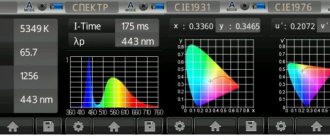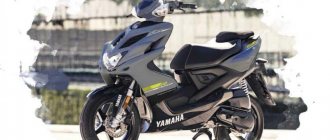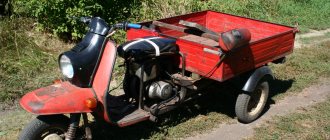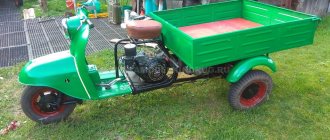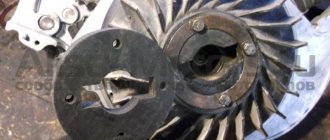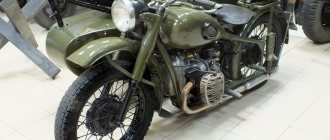Author: zaMKADpride
15 October 2015 13:30
Tags: vyatka mopeds scooter test drive
6789
18
At first, scooters seemed alien to Soviet society: what kind of foppishness is this – riding on horseback, but in comfort! Shoes are on a clean floor, knees are protected from wind and dust, the engine is hidden under the hood and therefore does not spit out oil and smoke... And these small bourgeois wheels?
0
See all photos in the gallery
In my October childhood, which fell in the 1970s, I still saw this unusual motor scooter on the streets. Vyatka stood out with its expressive, if not pretentious, appearance. Something outdated, from a nostalgic classic, was read in its convex forms, but that’s not why it was perceived as an alien body in the flow of traffic, but because of the boldness of the style. And then they suddenly disappeared from the streets...
Power point
The engine of the Vyatka scooter is a single-cylinder, two-stroke, and has the following characteristics:
- Working volume – 148 cubic cm.
- Compression ratio – 6.7.
- Cylinder diameter – 57 mm.
- Power – 5.5 l. With.
- The piston stroke is 58 mm.
- Torque – 3800 rpm.
The ignition of the Vyatka scooter is a contact magneto with manual adjustment of the gap and spark advance. The spark plugs used were standard A16 motorcycle spark plugs. This ignition system had one significant drawback: the constant high voltage caused the contacts to burn. A depression, the so-called “cavity,” developed in one tungsten plate, and a tubercle formed on the other contact plate during engine operation, which had to be periodically cleaned off.
The carburetor of the Vyatka scooter is a diffuser with one jet of limited range. The damper was driven by a cable from the right rotating steering wheel handle. Fuel entered the carburetor by gravity from the gas tank located under the seat. The tap, located at the bottom of the tank, was connected to the carburetor with a flexible hose made of gasoline-resistant rubber. The diameter of the hose clearance is sufficient for the unhindered supply of fuel. The fuel supply could be shut off by turning the tap handle. The carburetor was equipped with a special rod on the float chamber cover, designed to submerge the float before starting the engine in cold weather. When the rod was pressed, a free flow of gasoline opened, the mixture became richer, and the engine started.
The design of the chassis is a welded frame combined with a supporting stamped body. The body of a convenient layout allowed the driver to sit behind the wheel with sufficient comfort. The Vyatka scooter was ideal for those who didn’t want to drive fast. The two-seater seat easily accommodated both driver and passenger. Behind the seat there was a small luggage rack on which you could place a bag with things or some small cargo. Below the trunk, a brake light was mounted, and even lower, a bracket with a license plate. And this whole “ensemble” was completed by a rubber mudguard with the embossed inscription “VPMZ,” the abbreviation of the manufacturing plant.
Scooter owners noted such a significant drawback as overheating of the motor. The engine's location did not allow air to circulate to the extent needed for efficient cooling. In addition, the engine niche was tightly closed with casings on both sides. On the left side there is a stationary round-shaped trunk, and on the right side there is a removable casing that covers all the engine mechanisms. Longitudinal grooves were cut into this cap, designed to provide access to air masses, but they were not enough. Many scooter drivers removed the right cover to open up access to oncoming air flow, but such actions were stopped by the traffic police.
Model features
The Italian original, the Vespa 150GS from Piaggio, was intended as a lightweight city vehicle designed for travel on the smooth roads of Europe. In the USSR, the Vyatka VP-150 was used by the population as a full-fledged vehicle.
Residents of rural areas noted that when driving slowly on uneven, broken roads, the scooter engine does not overheat. This was possible thanks to the use of forced fan cooling of the engine in its design. It was also noted that the Vyatka VP-150 does not make much noise: a maximum of 80 decibels.
The design used a single-jet carburetor. Fuel is supplied by gravity from a 12-liter fuel tank under the seat through a flexible rubber hose; You can increase its flow by rotating the right handle of the steering wheel, and completely shut it off using the tap at the bottom of the tank. For the VP-150, A-66 gasoline could also be used. Fuel consumption per 100 km was 3.1 liters at a speed of approximately 50 km/h.
The VP-150 “Vyatka” scooter could accelerate to a speed that was good for that time - 70 km/h, but the dynamics left much to be desired: Vyatka accelerated to 60 km/h in 13 seconds. But the starting was soft and smooth.
The gearbox was a three-speed one, whereas the Vesp had 4 gears. Meanwhile, the body of the domestic model was made of thicker metal sheets, due to which it was several kilograms heavier and several centimeters longer than its foreign prototype. The scooter was designed for a maximum of two people.
The low location of the heaviest structural elements made the scooter very stable and maneuverable. It should be noted that the Vyatka engine was slightly offset from the center, but this did not affect its balance in any way.
There were also purely cosmetic differences:
- The ignition switch is located on the steering wheel; on the Vespa it was installed on the headlight housing;
- Round speedometer, whereas in the “original” it was oval;
- A sign with an inscription located on the shield;
- Since 1960, a small red flag with a star depicted on it was placed on the front wheel fender of the model;
- There were special hooks on which you could hang a helmet or bag.
Three-wheeled modifications
In the fall of 1959, at the exhibition “Motor scooters and motorcycles”, held at the Moscow Polytechnic Museum, various three-wheeled versions of the “Vyatka” were presented. The engine on all models was located in the middle, rotation was transmitted to the rear wheels through a bevel differential, and then to the rear drive wheels.
The Vyatka scooter in this version was widely used in the field of grocery delivery around the city. A total of three variants were produced: the MG-150F model, with a closed body, the MG-150 with an open platform, and the MG-150S with a dump body. All modifications had a carrying capacity of 250 kilograms. The speed of movement did not exceed 35 km/h.
Specifications
The wheelbase of the scooter is 1 20 cm, and the ground clearance is only 15 cm. The length of the model is 185 cm with a width of 80 cm and a height of 115 cm. Vehicle weight is 120 kg.
The engine is single-cylinder (57 mm in diameter), two-stroke, air-cooled. Working volume – 148 cc. Power 5.5 hp at 4.1 VKt at 4800 rpm.
The Vyatka has a multi-disc, “wet” clutch. Gear ratio - 3.04 in front gear, rear - 1.0, gearbox - 4.83-2.89-1.80. The front and rear wheel suspension is spring type, with a hydraulic shock absorber.
Impact on motor vehicles
The appearance of the Vyatka VP-150 had an impact on the domestic motorcycle industry. Based on the scooter, new transport models were developed, more advanced than their prototype. Thus, at the thematic exhibition of the Polytechnic Museum in Moscow in 1959, the three-wheeled Vyatka model was presented in three variations for different purposes:
- The MG-150F had a van body in its design;
- The MG-150 was equipped with a platform for moving cargo;
- The MG-150S had a dump truck body.
The new models were slow (maximum speed - 35 km/h), but their carrying capacity reached 250 kg.
Also based on the Vyatka, a version for passenger transportation was built. The three-wheeled motorcycle taxi VP-150T differed from the cargo variants in the front location of two steerable wheels. This transport did not gain much popularity - in total about five dozen of them were built.
By 1962, more than 100 thousand scooters had already been produced. At the end of the popularity of this line of scooters, at the end of 1965, another modification was presented to the world - VP-150M - which later received the name “Electron”. During 1966, it was produced simultaneously with the original model, after which their production was stopped. The reason for the departure of the VP-150 was the ability of the population to purchase familiar cars, and the rapidly growing popularity among the youth of the Czechoslovak “Java” in the late 60s.
Source
"Vyatka" as a service transport
At the request of VDNKh, the plant developed the VP-150T motorcycle taxi model, where the two driving wheels were located in front and were steerable. In addition to the driver in the back, there were two people in the front seat. The miniature vehicle aroused keen interest among the public and was in demand among visitors to the National Economy Exhibition.
To ride a motorcycle taxi from one pavilion to another, many were even willing to wait in a short line. The fare was symbolic. The motorcycle taxi was especially pleasing to the children, who asked their parents to ride again and again. Yes, actually, mom and dad weren’t averse to taking a ride on such an unusual vehicle either.
The motorcycle taxi was produced in the amount of 50 copies.
"Vyatka-Electron"
In 1965, a new model was developed based on the Vyatka 150. The scooter was named “Vyatka-Electron”. It differed from its predecessor in a new body with less rounded contours, an elongated base, a front long-link fork and more compact shock absorbers. At the same time, the Vyatka-Electron scooter retained the engine in its original form, but boosted to a power of 6 hp. With. Due to the extended base, it was necessary to make an intermediate chain drive, which became part of the rear wishbone suspension. The chain drive was hermetically sealed to prevent dust or dirt from getting into it in rainy weather.
Serial production of the new model began in 1967, and the outdated Vyatka 150 scooter was discontinued in the same year. The new model immediately gained popularity among young people. Being the owner of a beautiful sparkling car was considered prestigious. The economical motor of the scooter worked silently, and full filling of the gas tank cost no more than one ruble.
In 1973, the Vyatka-Electron scooter was modernized, the engine power increased and amounted to 7 hp. s., while fuel consumption remained the same - 3.1 liters per 100 kilometers. The design of the case has changed. But the main and most spectacular result of the scooter’s restyling was the installation of electronic contactless ignition. In the USSR, this was the first time the promising device was used. However, every new product has its positive and negative sides. If the electronics failed, the owner of the scooter could not figure out the problem on his own and was forced to look for special services or a private specialist to troubleshoot the problem. Thus, the supposed advantage often turned into criticism. But in general, the Vyatka-Electron scooter was a popular means of transportation.
Motor scooter Vyatka VP-150M
In the 60s, scooters were quite popular all over the world.
This fashion did not bypass the USSR, which famously copied its first models of scooters from foreign models. In our country, there were only two manufacturers of such equipment - the Tula Machine-Building Plant, which produced heavy Tula scooters, copied from the German Gogo, and the Vyatsko-Polyansky Machine-Building Plant, which launched the production of lighter Vyatka scooters, copied from the Italian Vespa. The first motor scooter “Vyatka” was born in 1957. It was a pot-bellied model VP-150, an almost exact copy of an Italian motor scooter. By 1965, there was a need to replace it, and VPMZM designers developed a modernized model VP-150M almost from scratch. Moreover, for this development the plant received a diploma from the Exhibition of Achievements of the National Economy.
It was decided to completely abandon the borrowed design of the first Vyatka, so the VP-150M received a completely new design in a modern style. All that remains from the previous model is the stamping of the front part of the body, but this can only be understood by removing the headlight and front fender. True, many did not like the appearance of the new model, but here, as they say, taste and color...
In addition to the new body panels, the Vyatka VP-150M is distinguished by its very approach to designing the stiffener frame structure. If the “pot-bellied” Vyatka had an all-welded body from stamped elements, then the new model had only the front part made according to this principle, and the rear part was welded from pipes. This made it possible to increase the overall rigidity of the structure and reduce its weight.
It was decided to abandon the rotating front wing - it turned out to be more reliable. The headlight was now also attached rigidly to the body lining, although this clearly had a negative impact on driving comfort at night. Probably, this decision was approved to please designers exposed to foreign influences.
The speedometer and central switch, combined with the ignition switch, are placed on the surface on top of the glove compartment. But before, both were located on the steering wheel. The glove compartment is quite spacious and can be locked with a key.
The most original detail of the Vyatka VP-150M is the direction indicators located at the ends of the steering handles. The solution is certainly unusual, but very impractical: the turn signals broke even when slightly dropped from the scooter. Therefore, it was decided to abandon them on the modernized Vyatka “Electron” model. By the way, it was the VP-150M that became the first domestic scooter to be equipped with direction indicators. A significant event, by the way, for the USSR.
The rear turn signals were combined into one unit with a brake light.
The front brake handle was on the steering wheel, and the rear brake was operated by a foot pedal, which was connected to the brake mechanisms via two metal rods. Also an unusual phenomenon for Soviet scooters, because the rest had a cable drive: rather inconvenient and unreliable.
Transmission – 3-speed manual. Gear shifting is carried out by rotating the left knob. The entire engine cover was now removable, providing perfect access to all mechanical parts. All you had to do was recline the seat, turn off the gas supply valve to the carburetor, remove the gas tank hose and unscrew the two screws. The tank, by the way, had a special handle by which it could be carried.
The seat in the new Vyatka VP-150M is locked.
The engine of the VP-150M scooter was received practically unchanged from the “Puzataya” Vyatka. This is a 1-cylinder, two-stroke, air-cooled power unit running on a mixture of gasoline and motor oil. But thanks to the use of a new carburetor and a different air filter, the power was increased from 5.5 to 6 hp.
Declining popularity
Despite its innovative characteristics, the Vyatka-Electron scooter gradually began to lose demand. And by the end of the 70s, its sales dropped to almost zero. Overstocking began in warehouses, and stores massively refused new supplies. The drop in demand is explained by the fact that the population has the opportunity to purchase cars on a larger scale. Many people preferred to buy domestic motorcycles; moreover, at the end of the 60s, deliveries of the Czechoslovak “Java” began to the USSR, which created a real sensation among young people.
As a result of all these changes, the Vyatsko-Polyansky plant stopped production of the Vyatka-Electron scooter in August 1979. The history of such a vehicle ends here. And in the early 90s, after the collapse of the Soviet Union, the plant launched the production of the small “Strizh” scooter, copied from the German “Simson”.
Repair support for motor scooters
More than thirty-five years have passed since production. Almost all scooters of both modifications - both "Vyatka" and "Vyatka-Electron" - have long since been scrapped. However, a certain number of cars are still in the hands of antique connoisseurs and collectors. Rare specimens need repairs, which means they need spare parts. The Vyatka-Electron scooter has been preserved better than its predecessor, but it also needs restoration. Spare parts can still be found at used equipment junkyards or even in stores that sell repair kits for motorcycles and scooters.
